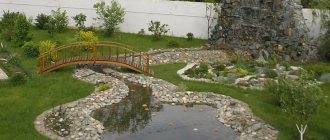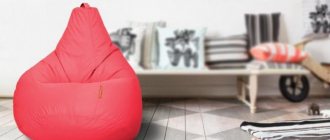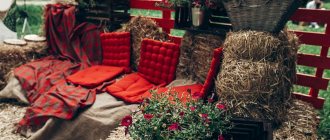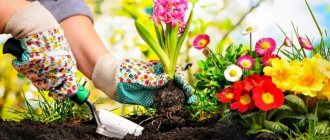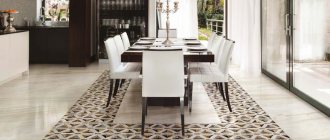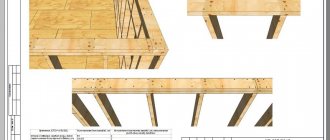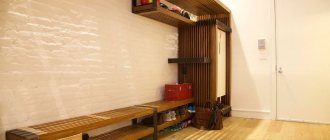Review author: Terra Design School
A spectacular and original design for garden flowers can add special charm to the local area, decorate a recreation area in the garden, veranda, gazebo or balcony. Hanging flowerpots not only look beautiful, but also significantly save space.
By showing a creative approach, it’s easy to make unusual flowerpots for the garden with your own hands, literally from scrap materials and various household items.
Cement and fabric planters
It will take a little time to create a cement pot. The task is so simple that anyone can do it without prior experience in such work.
You will need to prepare in advance:
- dry cement;
- an old tablecloth, burlap or bedspread;
- the shape of a suitable container (bucket, jar);
- paint;
- mixer-type drill attachment;
- water.
It is important to make sure before starting work that the size of the selected textile fabric matches the capacity of the flowerpot. Then the tablecloth (or piece of fabric) must be placed in a bucket, mark on the wall of the container how much space it takes up.
Take out the tablecloth and fill the bucket with water to the mark. Add dry cement and mix using a “mixer”. The consistency of the cement mixture should be similar to liquid sour cream.
A cloth (tablecloth) is placed in the resulting cement mixture so that the material is properly saturated. This procedure usually takes a few minutes.
Then the tablecloth is taken out and hung on the container chosen as the shape, which is first turned upside down. The edges of the tablecloth must be straightened at your discretion, giving the folds the desired shape.
After the cement has dried, it is recommended to paint the resulting product with a special paint for concrete. This procedure will not only decorate the product, but will also give it additional strength. After the paint has dried, the pot is ready to plant flowers in it.
A selection of varieties of the best “potted” flowers
When composing flower arrangements, plants are used that differ in bud color, height, splendor and stem type. Two or three types are planted in large flowerpots, with taller flowers (focal) in the center, two times lower along the edges (edging or background), and curly, cascading flowers around the circumference or perimeter.
If the container is near a wall, then taller plants are planted along the back wall, low or hanging plants are planted closer to the front edge. Let's take a closer look at which flowers are best planted in flowerpots rather than in flower beds.
Focal flowers - in the central space
Unpretentious, wildly blooming pelargonium, more familiar to everyone as geranium, pleases with a rich range of shades - from soft pink to deep burgundy. It is propagated by seeds and cuttings, but seedlings take root and grow better. During the summer, it is enough to feed with humates 2-3 times.
You can learn about why geraniums may stop blooming and how to fix it from the material:
Pelargonium easily tolerates frosts down to -3°C, but during cold spells it is better to cover flowerpots with plants at night with Agrospan.
Double and semi-double asters bloom thickly and for a long time. Dwarf and medium-sized varieties with a height of 15 to 50 cm are more suitable for flowerpots. They love the sun very much, so it is better to place containers on the south side.
You can sow aster seeds in the spring, but then they will bloom in late August-September, or in October - the flowers will bloom in June
Annual dahlias have a small height - from 20 to 50 cm, just suitable for creating compositions in flowerpots and containers. They look equally good both in group plantings and in single plantings. By using dahlias of different shades, you can get a picturesque bush to decorate your porch.
A garden gerbera can become a real decoration of the garden. The climate of central Russia is not suitable for year-round cultivation of this flower in open ground, but it is perfect for a mobile flowerpot:
If you plant dahlias in April, they will delight you with their bright colors from July until frost.
“Background” varieties - to create a border
Pansies are often called viola or violet. These are delicate, colorful plants 15-25 cm tall. They are great for framing taller plants in a large pot or creating a separate composition.
Recent Entries
Lilac perennials that are beautiful, compact and do not crowd out other plants Why when buying seedlings you should not take the sellers’ word for it and how to determine the age of the plant using 3 signs Tomato seedlings have turned purple or whitish: why the color has changed and how to save the plants
Pansies bloom throughout the summer. They are borders, so they are equally good for decorating flower beds, flowerpots, and balconies.
White, lilac, violet, burgundy ageratum serves as a lush frame for asters and dahlias. Taller plants (up to 30 cm) can be used to create contrasting compositions planted in different pots. Ageratum is not afraid of drought, but it does not like shade.
Ageratum seeds ripen at the end of summer, so they should be collected immediately as soon as the inflorescences turn brown.
Iberis blooms in May-June, so by mid-summer you can prepare other flowers to replace it. This is a lush plant, so seeds should be planted at 15 cm intervals. It loves the sun, but blooms just as well in the shade. Read more about landing.
More often than other varieties, umbrella iberis is used, which is excellent for decorating rock gardens, rockeries, balconies, porch steps and verandas.
Delicate white-yellow flowers of limnanthes look like little suns that illuminate everything around and give a great mood. A flowerpot or hanging basket with this neat plant will decorate your porch or balcony. Limnanthes is good as a background for bright focal plants in red or blue.
More information about limnantes varieties and caring for them can be obtained from the material: https://diz-cafe.com/rastenija/limnantes-vyirashhivanie-iz-semyan.html
Limnanthes seeds are planted in open ground, but earlier flowering can be achieved by preparing seedlings in the spring in a greenhouse
Hybrid verbena up to 30 cm high is also ideal for decorating flowerpots. Red and blue carnation-shaped flowers often have a white spot in the middle, making the bush look colorful and lively. Short shoots are good for creating straight bushes, long shoots are good for creeping compositions.
Verbena is great for planting in flowerpots, and with other flowers - pansies, ageratum - it creates classic purple-blue compositions
Falling and curly
Petunia is perhaps the most popular flower for decorating balconies and verandas. The variety of shades, from snow-white to deep purple and bright red, allows you to create incredibly beautiful compositions even without the use of other plants.
Petunia blooms throughout the warm season with lush caps. To make the plant look fresh, dry faded buds must be removed in a timely manner.
Various varieties of fuchsia are wonderful flowers for flowerpots in the country. Hanging and trailing plants create amazing combinations of red or pink. Hybrid fuchsia varieties are preferred for decorating balconies and gazebos.
The varietal diversity of fuchsia allows you to experiment with plants of different heights and colors. The varieties Marcus Graham, Sarah Jane, Summer are very beautiful
The bright cornflower blue flowers of lobelia pair harmoniously with blue or white focal plants. Blue is the most common color, but you can find white, purple and even red varieties that are used to create plain frames.
You can learn more about how to grow lobelia from the material:
Lobelia is one of those few flowers that tolerate transplantation well even during flowering, while its decorative qualities do not suffer
Sunny and positive nasturtium will not only decorate the facade of a house or a road curb, but will also replenish the first aid kit and even protect against pests. The plant is so unpretentious that it is one of the favorite flowers used for growing in the middle zone and in the north.
The length of nasturtium shoots reaches 2 meters, so it is used to create “blooming” walls, planted in flowerpots at the top of the house facade
Scaevola is suitable not only for flowerpots and containers - it is a ground cover plant that creates beautiful annuals. Among the other species, Scaevola pleasant stands out - a delicate plant with fan-shaped flowers of lilac color.
It is also worth paying attention to the delicate, profusely blooming brovallia. You can learn how to care for this flower from the material:
Scaevola grows very quickly, so to give it a neat shape you need to trim long shoots and pinch their tops
Plaster plant pots
It’s easy to make an unusually shaped flower pot with your own hands from plaster. It is easy to work with, pliable and cheap material. To its advantages it is necessary to add a short period of complete drying.
To create a flowerpot you will need:
- dry gypsum mixture;
- strips of fabric (up to 10 cm wide);
- wire;
- bucket or other form;
- dye;
- varnish
First of all, you need to make a wire frame. The easiest way is to braid it into a bucket of suitable capacity. If desired, it is not difficult to make the base of an original shape.
Then you will need to dilute the gypsum mixture with water until it becomes thick sour cream. Strips of fabric are alternately placed in the resulting composition, after which they are wound on a wire frame. To ensure the strength of the future product, the strips are wound overlapping. Several layers will be required.
The remaining gypsum mixture is evenly distributed on the surface of the workpiece. It will take about a day to dry completely.
The dried workpiece is decorated at your discretion. It is easy to paint the pots with acrylic paint, decorate them with pebbles, beads, pieces of ceramic tiles, and other original elements.
The final touch is to coat the product with colorless varnish as a protective layer. It’s easy to make flower pots from plaster in the form of stylized antique vases or elegant swans.
Landing technology
First of all, you need to put good drainage in the pot so that moisture does not stagnate near the roots. Can be used:
- a mixture of perlite and vermiculite in a 1:1 ratio;
- expanded clay;
- clay shards;
- Styrofoam;
- small pebbles.
The substrate must be suitable for this type of plant. Some gardeners recommend adding hydrogel to the soil or drainage - it absorbs moisture when it is in excess and releases it if the soil dries out. This helps regulate soil moisture, preventing both rotting and drying out of the roots.
Don't forget about planting technology
Many plants bloom profusely in relatively cramped pots, while in spacious ones they actively grow green mass.
After planting, it is recommended to cover the soil with mulch, for example, sphagnum moss. It protects the soil from drying out, prevents root rot, and has bactericidal properties.
Some people use pebbles for covering.
Wooden flower pots
There are many ways to make your own wooden planter.
Flowerpot made of wooden sticks
The simplest option would be to use wooden sticks for the work. You can use branches of the same size and straight shape for this purpose. The work will require a minimal set of tools and very little time. You need to stock up in advance:
- sticks or branches of the same length and diameter;
- strong cord or rope;
- plastic flower pot;
- a piece of burlap or cotton cloth;
- glue.
The first step in the work will be to wrap the pot with an existing piece of linen. Using glue, the fabric is firmly fixed, the top edge is folded into the pot.
Then the workpiece is covered with sticks, which are tightly tied with a cord. The edges of the sticks are placed so that they cover the top edge of the pot.
The result is an original decorative planting container that will harmoniously fit into any garden design.
Log planters
Having a small log, it is easy to turn it into a flowerpot for planting garden flowers. To do this you will need:
- a piece of log (stump, wooden block of a suitable shape);
- drill;
- chisel;
- protective composition for wood.
Having selected a wooden blank of a suitable size (or sawed off a piece of log), holes are drilled in it in a circle. Having thus destroyed the core of the workpiece, the wood is hollowed out using a chisel. The inner walls will need to be leveled and then impregnated with a primer to protect the wood from external influences.
A flower pot made from a large log can be placed on the surface of the ground, and a small container can be hung in a gazebo or on a tree branch. It is reasonable to line the hanging option from the inside with plastic film.
From timber
It’s easy to put together beautiful flowerpots from pieces of timber, forming them into a cube-shaped product. In this case, the flowerpot may have solid walls or sufficiently large gaps between the parts.
For a solid product, it is necessary to apply a protective impregnation. Flowerpots made of slats or timber with gaps are used as a base, placing flowers in containers or pots inside.
Such designs look very attractive, and their production will take very little time.
Houseplants
Despite the fact that for many subtropical plants (citrus, myrtle, some ornamental foliage) it is recommended to move them to the garden for the summer, which undoubtedly enhances growth in the fresh air, we do not recommend doing this. If you decide to use any indoor plants in a container garden composition, it is better to root cuttings or young rosettes in advance, from February, and use the plants as disposable ones (about cutting technology, see the article Cuttings of indoor plants at home). You may want to buy something specifically to implement your intended design.
| Agapanthus umbellata |
For placement in sunny places, use drought-resistant agaves, Kalanchoe Blossfeld (which blooms beautifully in the open air all summer). With slight shade and constant moderate soil moisture, plectranthus, chlorophytum crested, aucuba, fatsia japonica, hemigraphis alternating, decorative deciduous and flowering begonias, hypoestes phyllospica, southern cordyline, irezine, helichrysums, ivy, tradescantia, pelargonium, tolmia, calla lilies, rosemary are suitable , large-fruited cypress. However, the latter can be replaced without damaging the composition with annual kochia and, if necessary, given shape by cutting.
| Begonia ampelous |
|
Pots from waste materials
It is easy to use any waste materials to make flower pots. These can be plastic bottles, food containers, various canisters. Working with plastic is easy, it is malleable and can be easily painted in different colors with acrylic paint. Plastic canisters of non-standard shape make original products for planting garden flowers.
In addition to plastic containers, it is easy to use scraps of plastic pipes, tin cans of various capacities, old buckets, and car tires.
You can make an impressive hanging structure with several tiers from a plastic pipe.
Before you make a flowerpot for the garden with your own hands, you need to decide what kind of flowers will grow in it. This will help you correctly calculate the distance between tiers and the capacity of the product.
Street flowers in pots as a decorative element of the landscape
Many people want to have a house outside the city. This is an opportunity to spend a weekend closer to nature, in peace and solitude, away from the bustle and crowded streets. An obligatory component of a personal plot is outdoor plants. Someone purchased a building on an already green area and simply made adjustments or additions, but more often the arrangement is done from scratch.
If it is not possible to create a real flower garden, then you can always create a greenhouse from flowers in pots
Not a single design development, created by a professional or an amateur, is complete without flower beds. They make the structure bright and interesting and bring vibrant natural colors into the surrounding design. Flowers are an uncomplicated, unique way to decorate the most modest landscape. And it is accessible to everyone: if the composition of the soil, lack of space or any other reasons do not allow you to set up a flower garden, you can create a real greenhouse from flowers in pots. On the street, it is appropriate to place them on the ground, along paths, benches, gazebos... Or they can be mounted on a fence, pergola, terrace, or even on the wall of a house. The structure entwined with flowering plants looks truly fabulous.
Even if you don’t have a country house, you shouldn’t deprive yourself of the pleasure of being among flowers in the summer. Pots with plants can be mounted on the outside of the balcony, loggia, and even on the window slope. In specialty stores it is easy to find both the containers themselves and various devices for hanging and installation. It is possible to purchase a pot with a ready-made flower, but you can go from a seed or sprout to a blooming avalanche.
The finished plant option seems simpler only at first glance. It is important to organize adaptation correctly, otherwise the plant will lose its attractiveness. The second way is longer, but with proper care, the beginning of the growing season will bring a lot of pleasure.
Flower pots can be used not only in a country house, but also in a city apartment
Original ideas
- A creative approach will help you use various household items that are unsuitable for their intended use when decorating a flower garden. This could be old dishes or garden tools, for example, a watering can or an old kettle.
- Bird cages, old chandeliers and lamps, shoes, plastic fruit and vegetable boxes, furniture parts and any other items suitable as a planting container look impressive as flowerpots.
- It’s easy to decorate flower pots using jute cord, willow vine, small pebbles, fragments of ceramic tiles, and small-diameter wood cuts.
- It is convenient to use coconut shells, containers made of boards or timber, or baskets as flowerpots.
Making flowerpots with your own hands from inexpensive or waste material will allow you to decorate your garden or veranda with minimal effort and money.
Features of outdoor flowerpots
Outdoor flowerpots perform the same role as flowerpots - to hide an unsightly pot. Although the functions are the same, street flowerpots still have a number of features:
- they must be heavy so that the wind or a careless garden visitor does not accidentally knock them over;
- moisture resistant;
- with drainage holes (regardless of whether flowers are planted in them or flowerpots serve only as decoration).
By design, flowerpots can be stationary or portable, floor-standing, hanging, or wall-mounted.
Elegant flower stand
Vases made from boots - original and fun
Wicker baskets used as flowerpots create a unique charm

